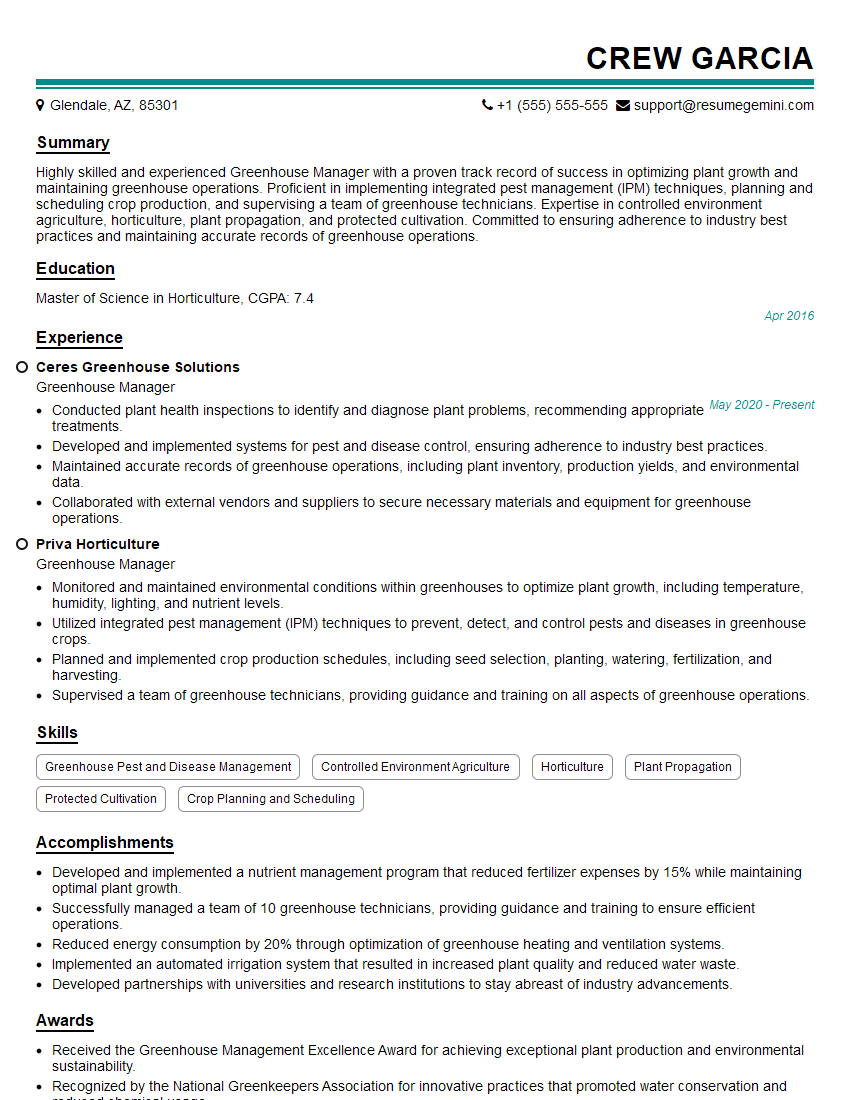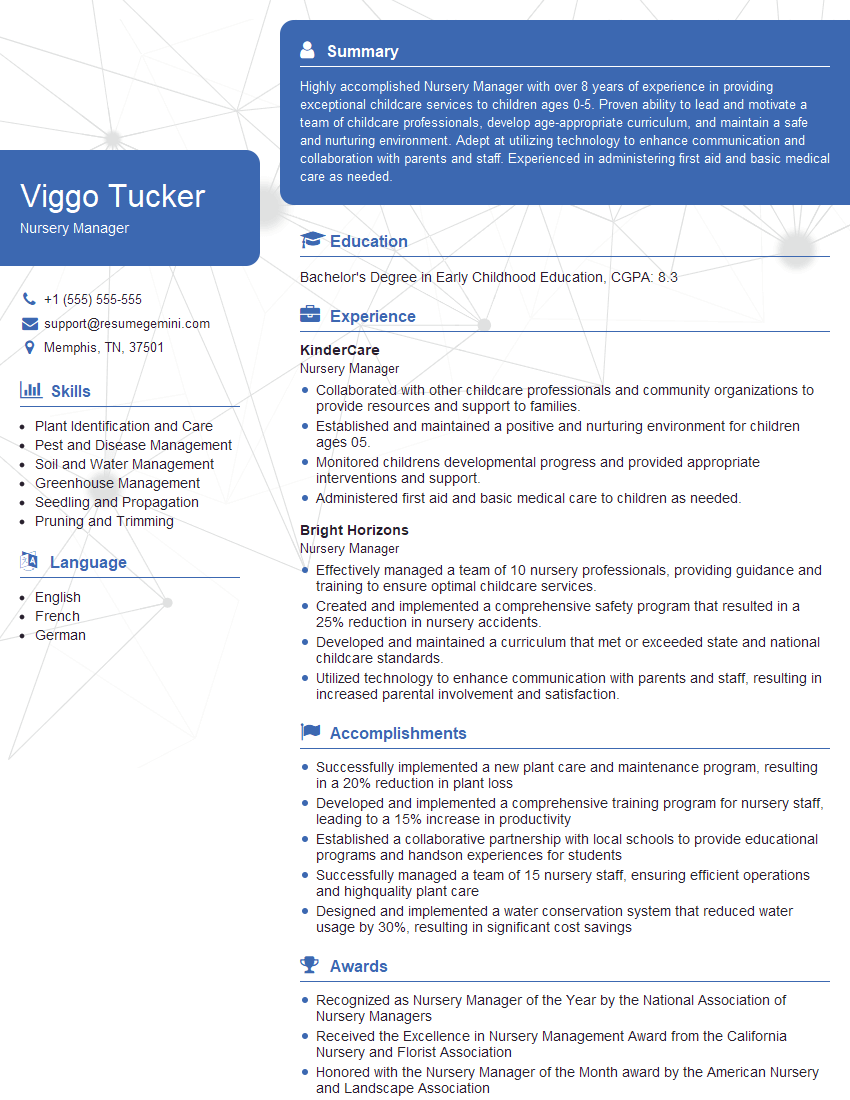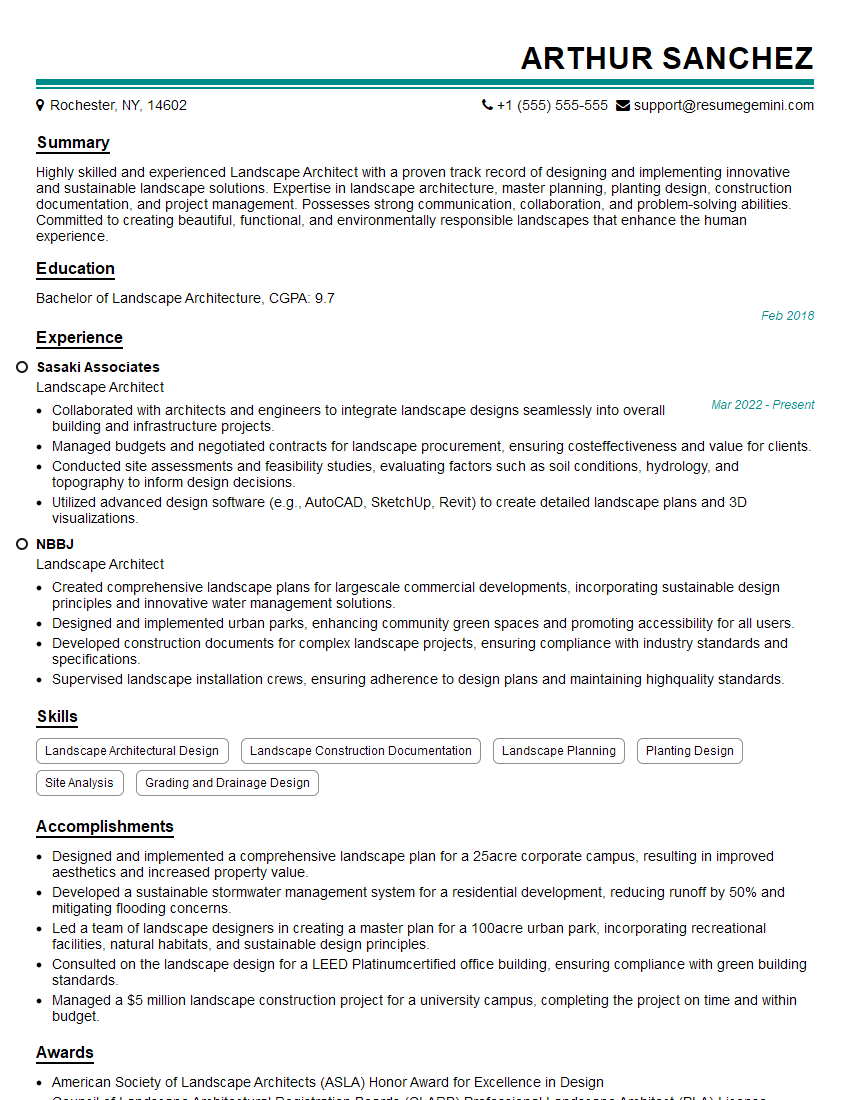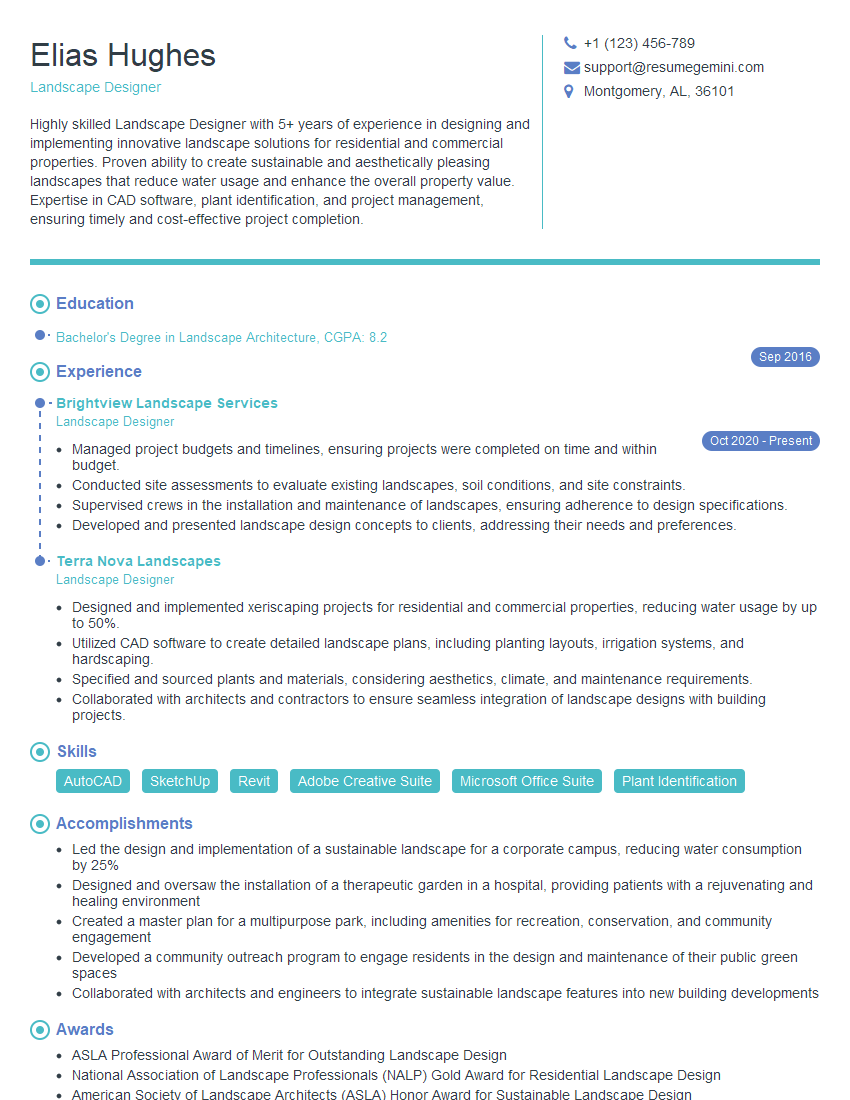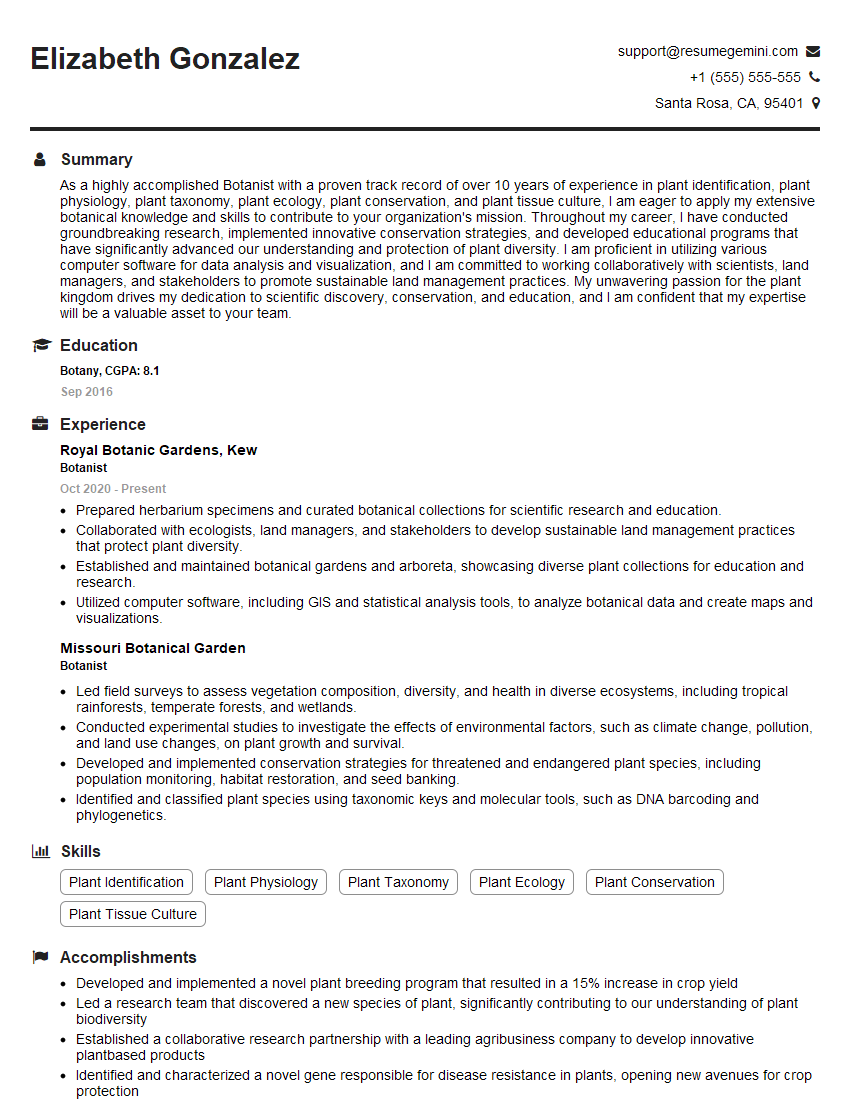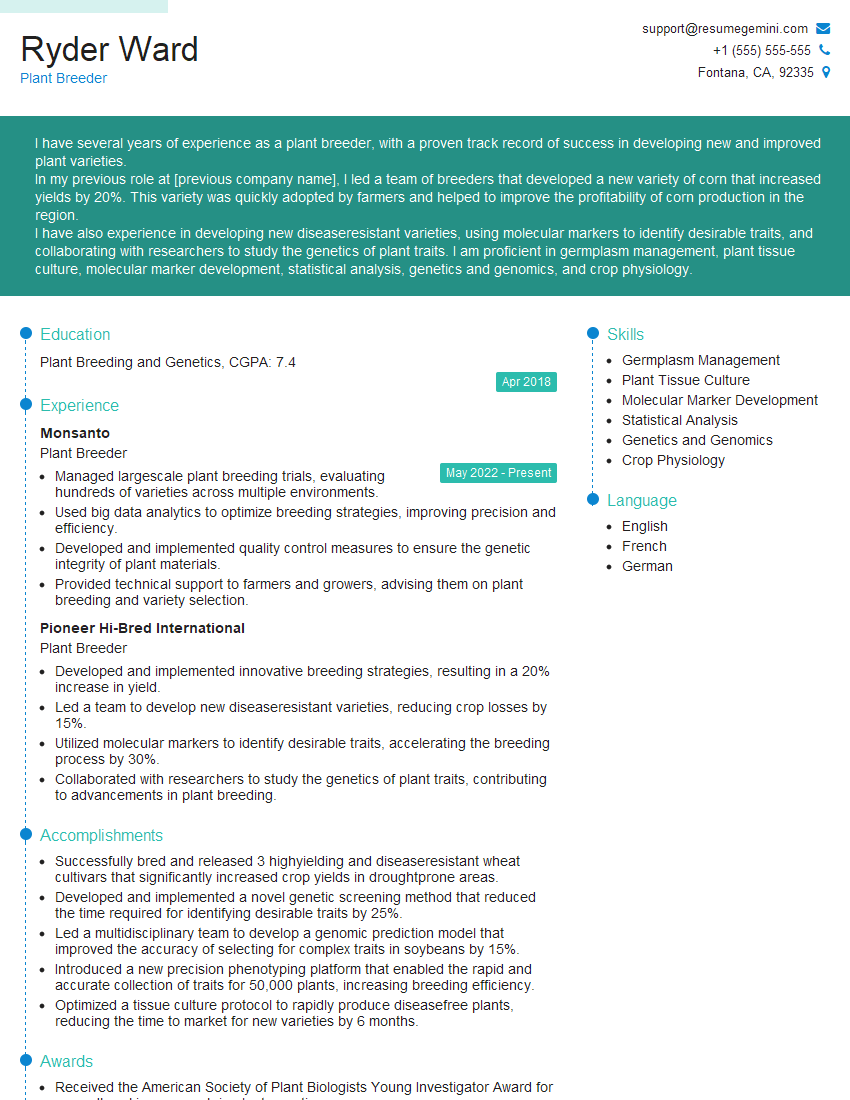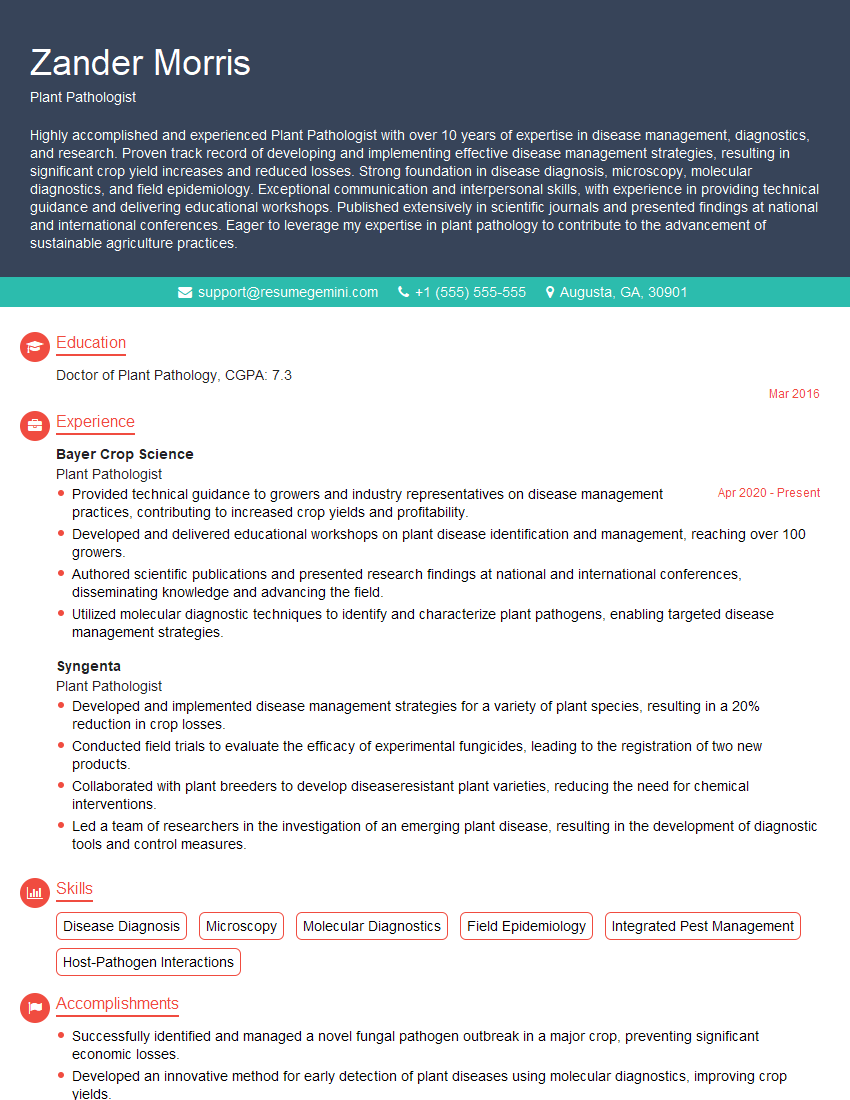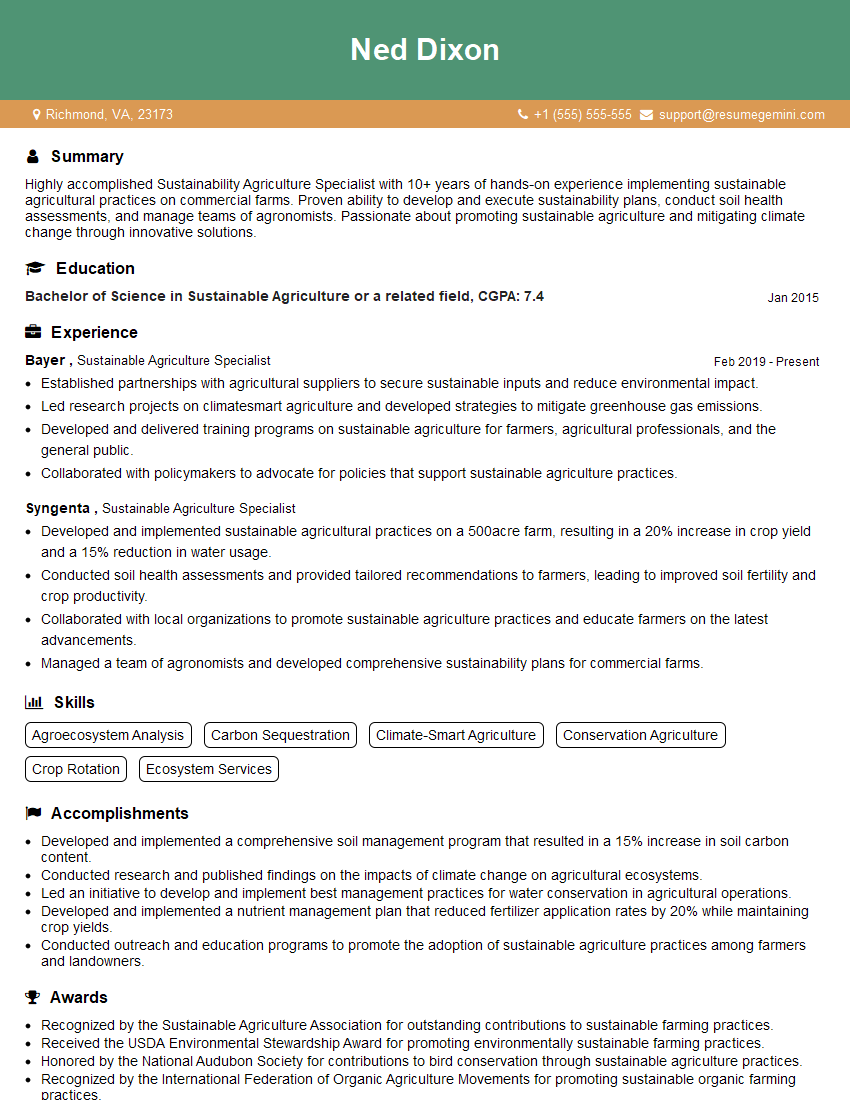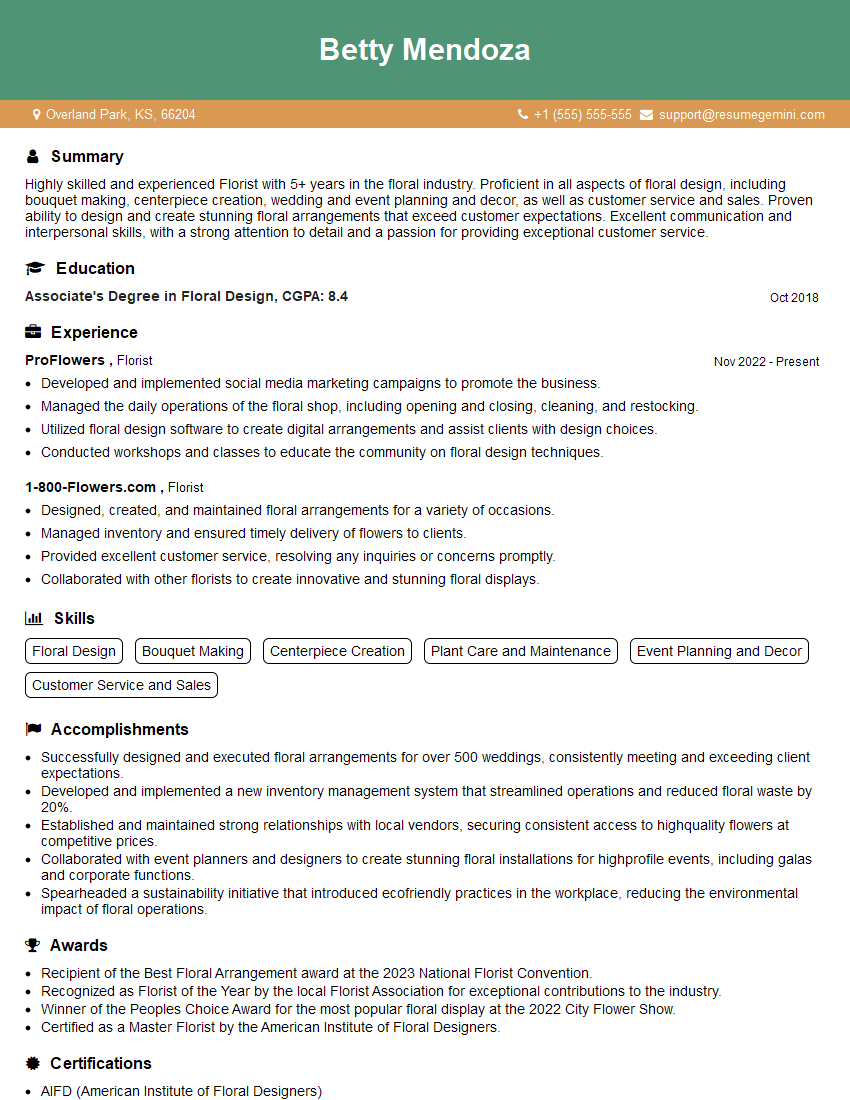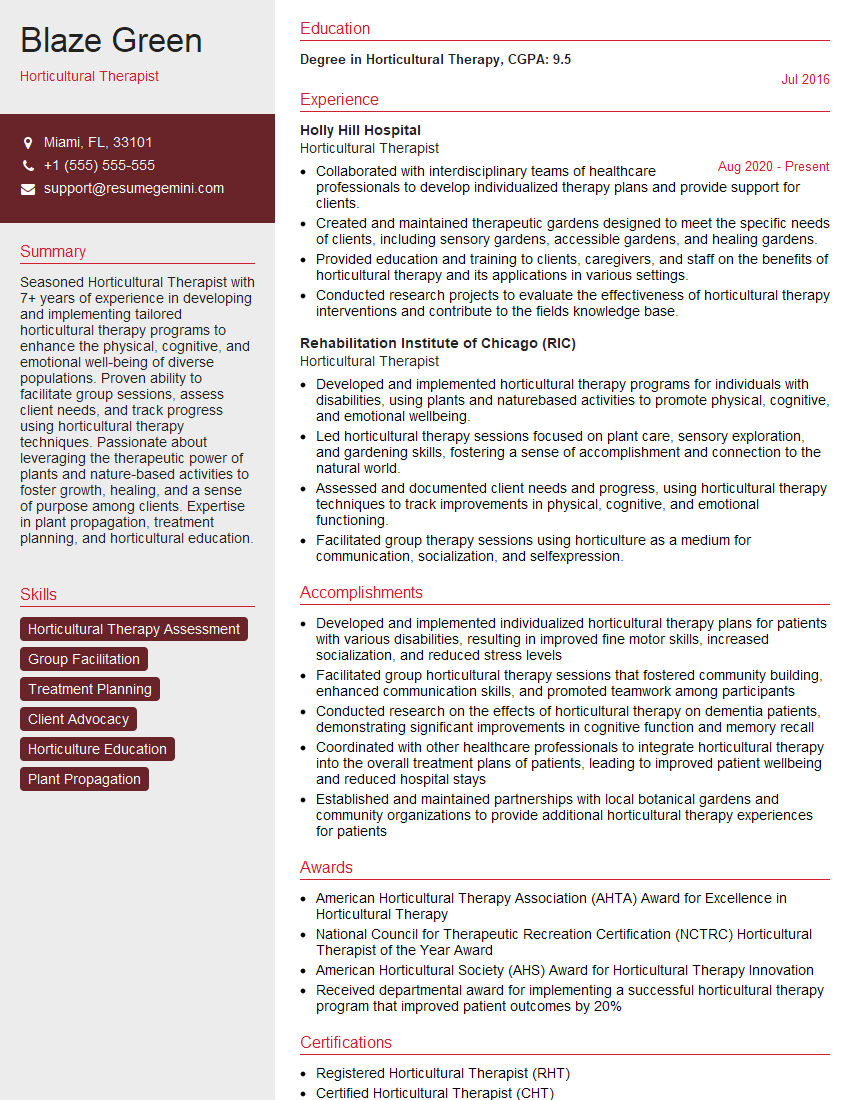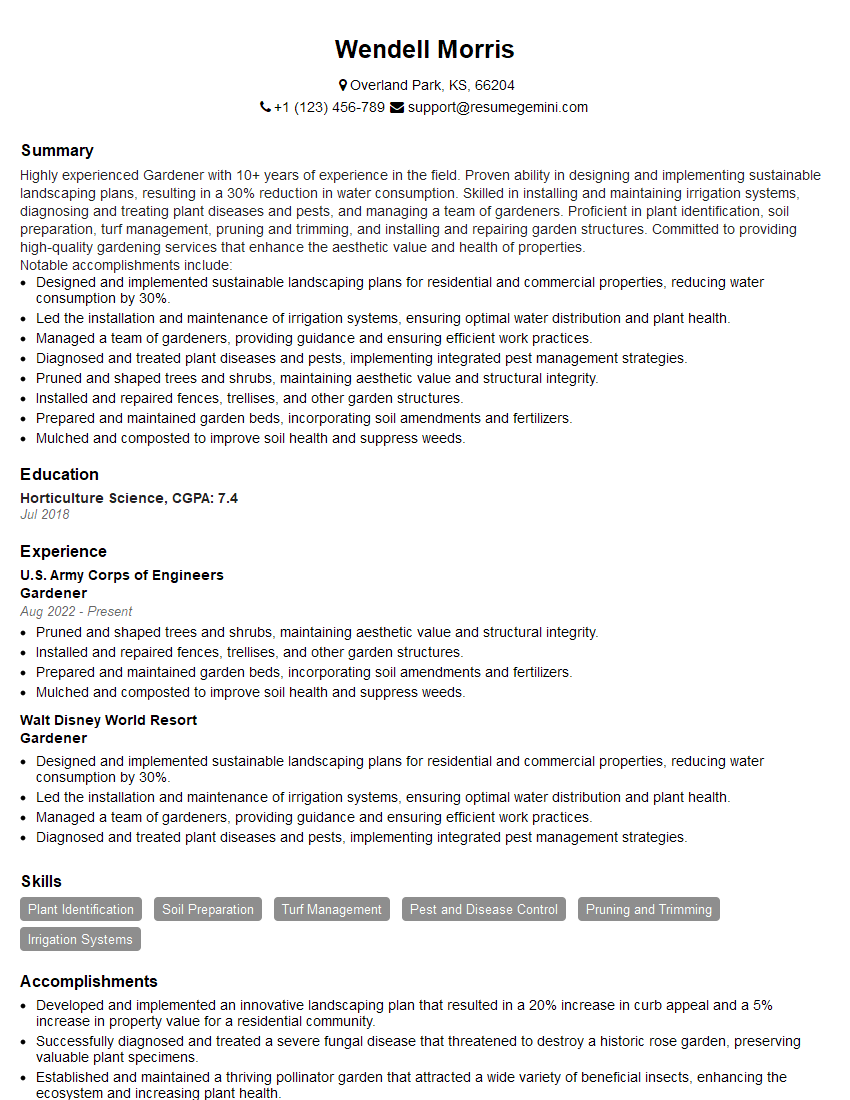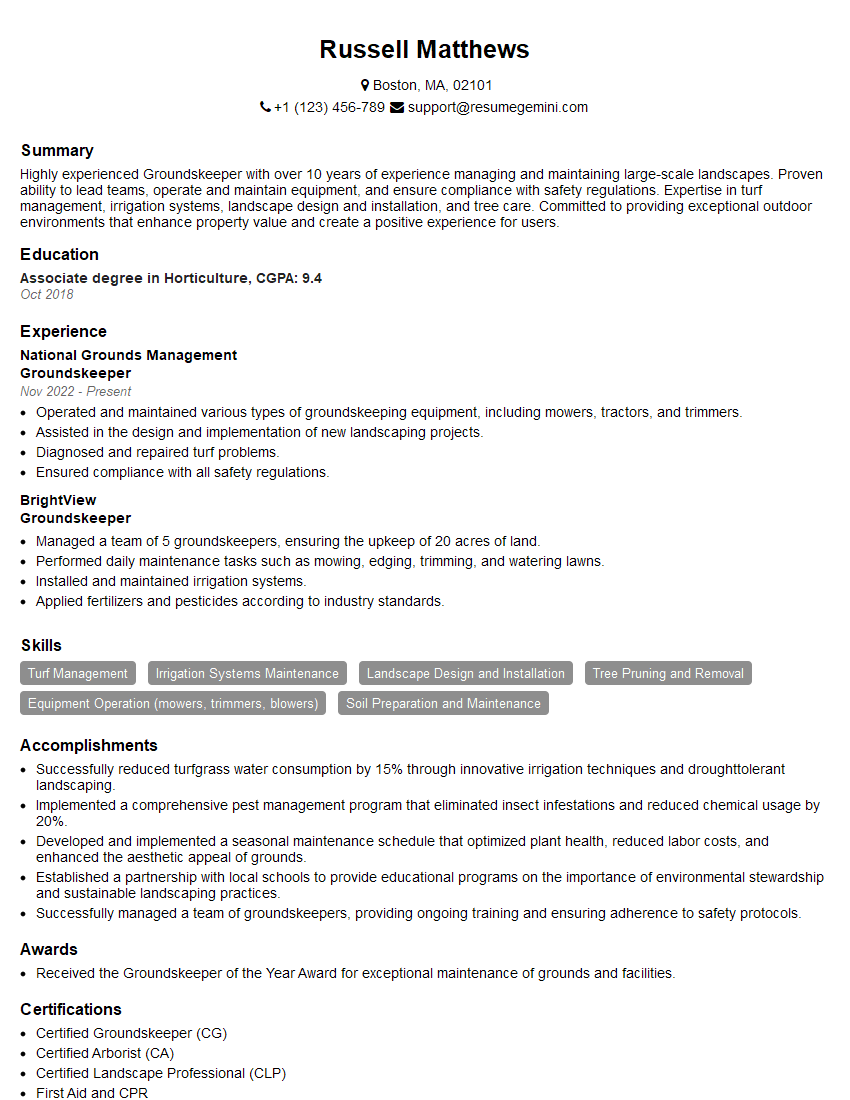Feeling uncertain about what to expect in your upcoming interview? We’ve got you covered! This blog highlights the most important Plant Selection and Care interview questions and provides actionable advice to help you stand out as the ideal candidate. Let’s pave the way for your success.
Questions Asked in Plant Selection and Care Interview
Q 1. Explain the principles of plant selection based on climate and soil conditions.
Selecting plants based on climate and soil is fundamental to their success. Think of it like choosing the right clothes for the weather – a tropical plant wouldn’t survive a harsh winter, just as a wool coat wouldn’t be suitable for a summer day.
Climate considerations focus on factors like temperature (average highs, lows, and frost dates), rainfall (amount and distribution throughout the year), and sunlight (hours of direct sun per day). For instance, a succulent thrives in hot, arid climates with plenty of sun, while a fern prefers shade and consistent moisture. Understanding the USDA Plant Hardiness Zones is crucial; it provides a geographic framework indicating the average annual minimum winter temperature for a specific area, helping you select plants that can withstand local winters.
Soil conditions encompass factors such as texture (sandy, silty, clay), pH (acidity or alkalinity), drainage, and nutrient content. A plant that prefers well-drained soil will struggle in heavy clay that retains water, potentially leading to root rot. Similarly, plants with specific pH requirements will show signs of nutrient deficiency if the soil pH is outside their tolerance range. For example, azaleas prefer acidic soil (pH below 6.5), while many vegetables thrive in slightly alkaline conditions (pH 6.5 – 7.5). Soil tests, discussed later, are invaluable in determining soil characteristics.
By carefully matching a plant’s needs to the local climate and soil profile, you dramatically increase the chances of successful establishment and long-term health.
Q 2. Describe various plant propagation methods and their suitability for different species.
Plant propagation involves creating new plants from existing ones. Several methods exist, each suited to different plant species.
- Seed propagation: This is the most common method and involves sowing seeds in suitable growing medium. It’s ideal for annuals, biennials, and many perennials. Think of sunflowers, tomatoes, or zinnias – easily grown from seed.
- Cuttings: This involves taking a stem, leaf, or root cutting from a parent plant and rooting it to develop into a new plant. This is effective for many shrubs and some herbaceous plants. For example, many flowering shrubs like hydrangeas can be easily propagated by stem cuttings.
- Layering: This technique involves bending a stem to the ground, burying a portion, and encouraging root formation before separating it from the parent plant. This is suitable for plants that readily produce roots along their stems, such as raspberries or forsythia.
- Division: This involves separating a mature plant into smaller sections, each with its own roots and shoots. This works well for clump-forming perennials like hostas or daylilies.
- Grafting and Budding: These advanced techniques involve joining a scion (desired plant part) to a rootstock (base plant) to combine desirable traits. This is often used for fruit trees or roses to improve fruit quality or disease resistance.
- Tissue Culture: This laboratory-based method uses small plant tissues to produce a large number of genetically identical plants. It’s particularly useful for propagating rare or difficult-to-propagate plants.
The choice of propagation method depends on the species’ characteristics, availability of resources, and desired outcome. For example, seed propagation is cost-effective for mass production, while tissue culture ensures genetic uniformity.
Q 3. How do you identify and address common plant diseases and pest infestations?
Identifying and addressing plant problems requires a systematic approach. Think of it as being a plant detective!
Disease identification involves observing symptoms like leaf spots, wilting, discoloration, or unusual growths. Photographs and plant samples can be helpful in obtaining accurate diagnoses, which might require consulting resources like university extension services or plant pathology experts. Accurate identification is key to selecting the appropriate treatment.
Pest identification similarly relies on observation. Common pests include insects (aphids, scale, spider mites), diseases (powdery mildew, fungal leaf spots), and other issues (weeds, nematodes). Careful examination of the plant, including the undersides of leaves and the soil, can reveal the culprits. Again, a good reference resource and proper identification are critical for success.
Addressing these problems involves integrated pest management (IPM), a holistic approach prioritizing prevention and minimal intervention. This might include:
- Cultural controls: Proper planting, watering, and fertilization practices to minimize stress and enhance plant vigor.
- Biological controls: Introducing beneficial insects or microorganisms to control pests. For example, ladybugs are natural predators of aphids.
- Mechanical controls: Physically removing pests (handpicking insects) or weeds.
- Chemical controls: Applying pesticides only as a last resort and following label instructions carefully.
Effective management often involves a combination of methods, and prevention through proactive cultural practices is crucial for long-term plant health.
Q 4. What are the key considerations for selecting plants for a specific landscape design?
Selecting plants for a landscape design goes beyond just aesthetics; it involves a careful assessment of multiple factors.
- Site conditions: Sunlight, soil type, moisture levels, and microclimate (e.g., wind exposure) are critical for plant survival and thrive. A sunny, dry location requires drought-tolerant plants, while a shady, moist area suits moisture-loving species.
- Plant size and form: Consider the mature size of plants to avoid overcrowding or insufficient space. Think about the plant’s shape (e.g., upright, spreading, weeping) and how it will fit within the overall design.
- Color and texture: Plants provide visual interest through color (flowers, foliage) and texture (leaf shape, bark). A balanced design incorporates a variety of colors and textures to create visual appeal.
- Plant function: Consider the role of plants in the landscape – screening, ground cover, hedging, specimen plants, etc. Different plants serve different purposes. For instance, evergreen shrubs might create a year-round screen, while flowering annuals add bursts of seasonal color.
- Maintenance requirements: Select plants that align with your maintenance capabilities and resources. Low-maintenance plants require less pruning, fertilizing, and watering.
- Sustainability: Consider selecting native plants, which are adapted to the local climate and require less irrigation and fertilization. They also support local ecosystems.
By carefully considering these factors, you can create a visually appealing and ecologically sound landscape that requires minimal intervention and maximizes plant health.
Q 5. Explain the importance of soil testing and its role in plant health.
Soil testing is paramount to understanding your soil’s characteristics and ensuring plant health. It’s like getting a check-up for your garden.
A soil test provides essential information on:
- pH: Indicates the soil’s acidity or alkalinity, affecting nutrient availability.
- Nutrient levels: Reveals the amounts of essential nutrients (nitrogen, phosphorus, potassium, etc.), identifying deficiencies or excesses.
- Organic matter content: Shows the amount of decaying organic material, impacting soil structure, water retention, and nutrient availability.
- Texture: Indicates the proportion of sand, silt, and clay, influencing drainage and aeration.
This information guides decisions on:
- Plant selection: Choosing plants that thrive in the existing soil conditions or amending the soil to suit the chosen plants.
- Soil amendments: Adding organic matter (compost), lime (to raise pH), or sulfur (to lower pH) to optimize soil conditions.
- Fertilization: Applying fertilizers tailored to the identified nutrient deficiencies, avoiding unnecessary inputs.
By addressing soil imbalances proactively, you can improve nutrient uptake, enhance plant growth, and reduce the risk of nutrient deficiencies or toxicities.
Q 6. Describe your experience with irrigation systems and water management techniques.
Experience with irrigation systems and water management is critical for successful plant establishment and growth. It’s about providing the right amount of water at the right time.
I have experience with various irrigation systems, including:
- Drip irrigation: Highly efficient, delivering water directly to plant roots, minimizing water waste and evaporation. Ideal for small gardens or individual plants.
- Sprinkler irrigation: Suitable for larger areas but can lead to more water loss through evaporation and runoff. Needs careful adjustment to prevent overwatering or underwatering.
- Soaker hoses: Deliver water slowly and evenly over longer lengths, suitable for rows of vegetables or flowerbeds. Less efficient than drip irrigation but simpler to install.
Water management involves understanding plant water requirements, soil type, and weather conditions. Overwatering can lead to root rot, while underwatering causes stress and wilting. Techniques such as mulching (adding organic material around plants) help to retain soil moisture, reducing the frequency of irrigation. Regular monitoring of soil moisture using a moisture meter or by feel is crucial. Efficient scheduling of irrigation, perhaps based on evapotranspiration (water loss from soil and plants) data, significantly conserves water and enhances plant health.
Q 7. How do you determine the appropriate fertilization schedule for different plants?
Fertilization is crucial for providing plants with the essential nutrients they need for growth. A balanced approach is key, avoiding over-fertilization which can harm plants and the environment.
Determining the appropriate fertilization schedule depends on several factors:
- Plant type: Different plants have different nutrient requirements. Fast-growing plants require more frequent fertilization than slow-growing ones. For instance, annual vegetables require frequent fertilization during the growing season, whereas established trees need less frequent applications.
- Soil test results: Soil testing (as mentioned earlier) identifies nutrient deficiencies, guiding the type and amount of fertilizer to apply. This avoids over-application of already abundant nutrients.
- Plant growth stage: Fertilization needs vary at different growth stages. Young plants may need more nitrogen for vegetative growth, while mature plants require more phosphorus and potassium for flowering and fruiting.
- Time of year: Fertilizing schedules often align with the growing season. Fertilization may be reduced or ceased during dormancy.
- Fertilizer type: Different fertilizer types (e.g., slow-release, granular, liquid) have different release rates, impacting the frequency of application.
A common approach is to follow the fertilizer label instructions but always consider soil test data and the plant’s specific needs. It’s often better to fertilize less frequently with a balanced fertilizer than to over-fertilize with quick-release products. Regular monitoring of plant health helps to ensure the fertilization schedule is effective.
Q 8. Discuss the importance of pruning and its impact on plant growth and health.
Pruning is the selective removal of parts of a plant, such as branches, leaves, or roots, to improve its shape, health, and productivity. Think of it like a haircut for your plants – it’s essential for maintaining their well-being.
Impact on Plant Growth and Health:
- Improved Air Circulation: Removing overcrowded branches allows for better airflow, reducing the risk of fungal diseases and pest infestations. Imagine a crowded room – it’s stuffy and prone to problems. The same applies to plants.
- Increased Light Penetration: Pruning opens up the plant’s canopy, allowing more sunlight to reach inner leaves and promoting more vigorous growth. Think of it like giving each leaf its own personal sunbath!
- Enhanced Fruit and Flower Production: Strategic pruning can direct the plant’s energy towards producing more flowers and fruits, leading to a bountiful harvest. It’s about focusing the plant’s resources.
- Shape and Size Control: Pruning helps maintain the desired shape and size of a plant, preventing it from becoming overgrown and unruly. This is crucial for aesthetics and managing space.
- Removal of Dead or Diseased Parts: Pruning removes dead, damaged, or diseased branches, preventing the spread of infections and improving the plant’s overall health. It’s like removing a splinter to prevent infection.
Practical Application: The specific pruning techniques vary depending on the plant species and its growth habit. For example, fruit trees often require different pruning methods compared to flowering shrubs. Knowing the plant’s natural growth pattern is key.
Q 9. What are the different types of plant supports and when are they necessary?
Plant supports are structures used to provide physical support to plants, especially those with weak stems or heavy foliage. They prevent plants from falling over, especially in windy conditions or when bearing heavy fruits or flowers.
Types of Plant Supports:
- Stakes: Individual stakes, usually wooden or bamboo, are driven into the ground next to the plant and used to tie up individual stems. Great for smaller plants needing gentle support.
- Trellises: These are frameworks of vertical supports, often made of wood or metal, providing support for climbing or sprawling plants like roses and cucumbers. Think of a vertical ladder for your plants.
- Cages: These are cylindrical structures, often wire or plastic, that surround a plant, providing support for its entire structure. Tomatoes and some flowering plants benefit from this.
- Obelisks: These are decorative, tall pointed structures that provide vertical support and a focal point in the garden. They work especially well for climbing plants.
When Plant Supports Are Necessary:
- Weak Stems: Plants with slender, fragile stems are prone to breakage and need support.
- Heavy Foliage or Flowers: Plants with large leaves or heavy blooms may need support to prevent them from bending or breaking.
- Windy Conditions: In windy areas, plant supports are crucial to protect plants from being damaged or uprooted.
- Tall Plants: As plants grow tall, they may need support to prevent them from falling over.
Q 10. Describe your experience with integrated pest management (IPM) strategies.
Integrated Pest Management (IPM) is a sustainable approach to pest control that aims to minimize pesticide use while maximizing the effectiveness of other methods. It’s all about finding the right balance between protecting your plants and protecting the environment.
My experience with IPM involves a multi-pronged approach:
- Regular Monitoring: Closely observing plants for signs of pests or diseases is the first step. Early detection allows for timely intervention, preventing widespread infestations.
- Cultural Practices: Using methods like crop rotation, proper watering, and providing appropriate sunlight help to create a less hospitable environment for pests.
- Biological Control: Introducing natural predators like ladybugs or lacewings can effectively control pest populations. It’s nature’s way of balancing things.
- Mechanical Control: Using physical methods like handpicking pests or setting traps helps reduce pest populations without resorting to chemicals.
- Chemical Control (as a last resort): Only when other methods are ineffective, I use pesticides, selecting the least toxic and most targeted option. This ensures minimal impact on beneficial insects and the environment.
Example: In managing aphids on roses, I might first try using a strong spray of water to knock them off. If that fails, I might introduce ladybugs to feed on the aphids before resorting to a targeted insecticide.
Q 11. How do you manage plant stress caused by environmental factors?
Plant stress from environmental factors can significantly impact their health and productivity. It’s crucial to identify the stressors and implement appropriate management strategies.
Managing Plant Stress:
- Water Stress: Proper watering is crucial. Overwatering can lead to root rot, while underwatering causes wilting. Understanding the specific water requirements of each plant is paramount.
- Light Stress: Providing adequate sunlight is essential for photosynthesis. Too little light results in weak growth, while too much can cause scorching. Knowing the plant’s light needs (full sun, partial shade, etc.) is key.
- Temperature Stress: Extreme temperatures, both hot and cold, can damage plants. Protection from frost (using covers or relocating plants) and shade from intense heat are often necessary.
- Nutrient Deficiency: Soil testing and proper fertilization ensure the plant receives the necessary nutrients. Deficiencies manifest in yellowing leaves or stunted growth, often indicating a need for specific nutrients.
- Pest and Disease Stress: Implementing IPM strategies prevents or manages pest and disease infestations. Early detection and appropriate action are crucial to minimize damage.
Example: A wilting tomato plant might indicate either underwatering or root rot (overwatering). Careful observation of soil moisture and the plant’s overall appearance helps diagnose the problem and determine the appropriate solution.
Q 12. Explain the concept of plant hardiness zones and their relevance to plant selection.
Plant hardiness zones are geographical areas with similar average annual minimum temperatures. They’re a critical tool in selecting plants that will thrive in a particular location. Essentially, it’s like choosing clothes appropriate for the weather – plants need the right climate too.
Relevance to Plant Selection:
Each zone is numbered, with lower numbers indicating colder climates and higher numbers indicating warmer climates. By knowing your hardiness zone, you can choose plants that can survive the coldest temperatures your region experiences. Trying to grow a plant outside its hardiness range is often unsuccessful, leading to plant death or poor performance. You wouldn’t try to wear a swimsuit in an arctic blizzard – you need the right gear, and plants need the right zone.
Practical Application: Many plant labels specify the hardiness zones they are suitable for (e.g., Zones 5-9). Before purchasing a plant, check its hardiness zone to make sure it’s appropriate for your location. Online resources and local nurseries can help determine your zone and provide recommendations.
Q 13. Describe your experience with plant tissue culture techniques.
Plant tissue culture is a technique for growing plants from small pieces of plant tissue in a sterile, nutrient-rich medium. It’s a bit like cloning plants in a lab, allowing for rapid propagation of desirable plants.
My experience involves:
- Sterilization: Proper sterilization techniques are crucial to prevent contamination of the cultures.
- Media Preparation: Preparing a sterile growth medium with the appropriate nutrients and hormones is essential for successful growth.
- Inoculation: Transferring small pieces of plant tissue (explants) onto the growth medium under sterile conditions.
- Incubation: Providing optimal environmental conditions (light, temperature, humidity) for the cultures to grow.
- Subculturing: Transferring plantlets to larger containers as they grow, ensuring continued growth and development.
- Acclimatization: Gradually introducing the plantlets to outdoor conditions to prepare them for transplantation.
Practical Applications: Plant tissue culture is used for various purposes, including:
- Rapid propagation: Producing large numbers of identical plants quickly and efficiently.
- Disease elimination: Producing disease-free plants from infected parent plants.
- Germplasm conservation: Preserving rare or endangered plant species.
- Genetic engineering: Producing genetically modified plants.
Q 14. How do you assess the maturity and health of a plant before planting?
Assessing a plant’s maturity and health before planting is crucial for ensuring its successful establishment. It’s like checking if a seedling is ready for kindergarten.
Assessing Maturity:
- Size and Growth Stage: The plant should be of an appropriate size for its species and growth stage. Seedlings need to be robust enough to handle transplanting.
- Root System: A healthy root system is essential for water and nutrient uptake. Check for strong, well-developed roots. Weak or damaged roots indicate a less healthy plant.
- Stem Strength: The stem should be firm and upright, indicating a healthy plant. Weak or spindly stems suggest a less robust plant that might struggle.
Assessing Health:
- Leaf Appearance: Leaves should be a healthy color (varying based on species), free from spots, wilting, or discoloration. Unusual color or patterns could indicate disease or nutrient deficiency.
- Pest and Disease Signs: Check carefully for any signs of pests (like insects or mites) or diseases (spots, mold, wilting). These could compromise the plant’s ability to thrive.
- Overall Vigor: A healthy plant should exhibit strong growth and a vigorous appearance. A plant that appears weak or stunted might not have the energy to thrive after transplanting.
Practical Application: Before planting, carefully examine the plant for any signs of poor health or immaturity. Reject plants showing signs of damage, disease, or pests. Choosing healthy, robust plants greatly increases the likelihood of successful establishment.
Q 15. What are the signs of nutrient deficiencies in plants and how do you address them?
Nutrient deficiencies manifest in plants through a variety of visible symptoms, often specific to the deficient nutrient. Think of it like a human diet – if you lack essential vitamins, you’ll show symptoms. Similarly, plants lacking vital nutrients exhibit characteristic signs. For example, nitrogen deficiency often results in pale green or yellowing leaves, starting from the older leaves and progressing upwards. This is because nitrogen is mobile within the plant, and it relocates from older leaves to support newer growth. Phosphorus deficiency can lead to stunted growth, dark green or purplish leaves, and delayed flowering. Potassium deficiency often causes leaf margins to scorch and brown, starting at the edges and moving inwards.
Addressing nutrient deficiencies requires a multi-pronged approach. First, accurately diagnose the problem. Visual inspection is crucial, but soil testing can confirm your suspicions. Soil testing provides a quantitative measure of the available nutrients in the soil, allowing for targeted supplementation. Once the deficiency is identified, appropriate fertilizers can be applied. For instance, a high-nitrogen fertilizer would be suitable for nitrogen deficiency. Slow-release fertilizers provide a gradual and sustained supply of nutrients, reducing the risk of over-fertilization. Organic amendments like compost also improve soil structure and nutrient availability. Remember to follow label instructions carefully and avoid over-fertilizing, as this can damage plant roots and harm the environment. Proper watering is also crucial; waterlogged soils can impede nutrient uptake.
- Example: I once had a client with tomato plants exhibiting pale yellow leaves. Soil testing revealed a significant nitrogen deficiency. We applied a balanced fertilizer with a higher nitrogen content, and the plants quickly recovered, producing a bountiful harvest.
Career Expert Tips:
- Ace those interviews! Prepare effectively by reviewing the Top 50 Most Common Interview Questions on ResumeGemini.
- Navigate your job search with confidence! Explore a wide range of Career Tips on ResumeGemini. Learn about common challenges and recommendations to overcome them.
- Craft the perfect resume! Master the Art of Resume Writing with ResumeGemini’s guide. Showcase your unique qualifications and achievements effectively.
- Don’t miss out on holiday savings! Build your dream resume with ResumeGemini’s ATS optimized templates.
Q 16. Explain the differences between annuals, biennials, and perennials.
Annuals, biennials, and perennials are categorized based on their life cycle – how long they live and reproduce. Think of it like a plant’s lifespan. Annuals complete their entire life cycle – germination, growth, flowering, seed production, and death – within a single growing season. Examples include zinnias and marigolds. They offer vibrant color and are perfect for seasonal displays. Biennials complete their life cycle in two years. In the first year, they focus on vegetative growth; in the second, they flower, produce seeds, and die. Carrots and parsley are excellent examples of biennials; they form a root structure in year one and then flower and seed the following year. Perennials live for three or more years, often flowering and producing seeds annually. Many flowering shrubs and herbaceous perennials fall into this category – lavender, hostas, and daylilies. Perennials offer long-term landscaping solutions and frequently display more impressive growth over time.
Q 17. How do you select plants to attract pollinators or beneficial insects?
Selecting plants to attract pollinators and beneficial insects is essential for a healthy ecosystem in your garden. Think of it as creating a buffet for your garden’s helpers! Different pollinators and insects prefer specific types of plants. Native plants are generally the best choice as they’ve co-evolved with the local insect populations. To attract pollinators like bees and butterflies, choose plants with abundant nectar and pollen, like coneflowers, lavender, and sunflowers. These plants often have brightly colored flowers and a pleasant fragrance. To attract beneficial insects such as ladybugs and lacewings, that prey on common garden pests, select plants that provide food and shelter. Yarrow, dill, and fennel are excellent examples. Creating diverse planting schemes with varying bloom times ensures a continuous food source throughout the growing season. The more diverse your plantings, the more biodiversity you’ll attract.
- Example: In a recent landscaping project, we integrated a variety of native wildflowers and herbs to attract beneficial insects and pollinators, significantly reducing the need for chemical pest control.
Q 18. Describe your experience with the maintenance and care of different types of plant containers.
My experience with container gardening encompasses a wide array of materials and sizes. From terracotta pots to plastic containers and self-watering systems, each presents unique challenges and rewards. Terracotta pots are porous, leading to faster drying and increased watering frequency. This requires more diligent monitoring, especially in hot and sunny climates. Plastic containers retain moisture better, reducing the need for frequent watering but potentially increasing the risk of overwatering and root rot. Self-watering containers offer convenience but require careful attention to water levels to avoid root rot. Regardless of the container material, proper drainage is critical. Containers should have drainage holes to prevent waterlogging. The size of the container also significantly impacts plant health. Overcrowded roots in smaller containers can lead to stunted growth. Therefore, selecting the appropriate container size for the plant’s mature size is essential. Regular cleaning of containers is vital to prevent the buildup of salts and diseases. I frequently advise clients on appropriate container choices depending on their plant selections and overall gardening experience.
Q 19. How do you manage weeds and prevent weed infestation?
Weed management is a crucial aspect of plant care. Prevention is key! Mulching is a highly effective strategy. A layer of mulch, such as wood chips or straw, suppresses weed growth by blocking sunlight. This prevents weed seeds from germinating. Regular weeding is also important. Hand weeding is ideal for small areas and allows for precise removal of weeds, including their roots. For larger areas, hoeing can effectively cut weeds at the soil surface, preventing further growth. However, be careful to avoid damaging the roots of your desired plants. In some cases, pre-emergent herbicides can prevent weed seeds from germinating. However, these should be used judiciously and according to label instructions, as they can also affect desired plants. Careful soil preparation before planting, removing existing weeds and their roots, can minimize future weed problems. Crop rotation can also decrease weed prevalence by interrupting weed life cycles. Finally, understanding the types of weeds prevalent in your area is critical for effective management.
Q 20. Explain the process of designing and installing a drip irrigation system.
Designing and installing a drip irrigation system involves several key steps. First, plan the layout, considering the location of plants and water sources. Measure distances and identify the number and placement of emitters (drippers) for each plant. Then, select appropriate components: a water source (hose bib or well pump), pressure regulator, tubing, and emitters. The tubing should be laid out following the plan; different sizes of tubing cater to varying water pressures and flow rates. Emitters are attached to the tubing, providing precise water delivery to individual plants. Consider using a filter to prevent debris from clogging the system. Once the system is installed, test its functionality. This ensures that the water pressure and flow are appropriate for each plant and that all emitters are functioning correctly. Regular maintenance, including flushing the system, is vital to prevent clogs. Drip irrigation offers significant advantages over traditional sprinkler systems; it conserves water and reduces weed growth through targeted watering. It’s an essential component in efficient and sustainable gardening practices.
Q 21. How do you evaluate the effectiveness of plant care strategies?
Evaluating the effectiveness of plant care strategies requires a multi-faceted approach. Regular observation of plant health is paramount. Are the plants growing vigorously? Are they flowering and fruiting as expected? Are there any signs of disease or pest infestation? Visual inspection provides a qualitative assessment. Quantitative measurements can supplement these observations. For example, measuring plant height and girth over time can indicate growth rates. Assessing fruit or vegetable yield provides another crucial metric. Yield data can be compared across different plant care strategies or over different growing seasons. Soil testing can help evaluate the effectiveness of fertilization and soil amendment practices. Documenting observations and measurements in a journal or spreadsheet allows for a structured analysis and comparison over time. This allows you to identify successful strategies and refine approaches that need improvement. Continuous monitoring and adjustment are fundamental aspects of effective plant care.
Q 22. What are the key considerations for winterizing plants in cold climates?
Winterizing plants in cold climates is crucial for their survival. It involves preparing them to withstand freezing temperatures, snow, and ice. This process is akin to preparing yourself for a harsh winter – you need the right gear and precautions.
- Mulching: Applying a layer of mulch (wood chips, straw, etc.) around the base of plants insulates their roots, protecting them from frost. Think of it as a cozy blanket for the roots.
- Watering: A deep watering before the first hard freeze helps plants retain moisture, which is vital for surviving winter stress. This is like ensuring you have enough water stored before a long journey.
- Protection from Wind and Sun: Strong winds and intense winter sun can desiccate plants (dry them out). Windbreaks, burlap wraps, or moving containers to sheltered locations can significantly reduce this damage. This is analogous to protecting yourself from harsh weather conditions.
- Pruning: Removing dead or damaged branches allows better air circulation and prevents the accumulation of snow and ice. Imagine cleaning up your workspace to make it more efficient.
- Plant Selection: Choosing cold-hardy plant varieties adapted to your specific climate zone is fundamental. You wouldn’t wear shorts in a blizzard, right? Similarly, you need plants that can handle the cold.
For instance, I once helped a client winterize their newly planted roses. We used a combination of mulching, deep watering, and wrapping the bushes with burlap to protect them from the harsh winds during the winter months. They flourished the following spring.
Q 23. Discuss the impact of climate change on plant health and selection.
Climate change significantly impacts plant health and selection. Rising temperatures, altered precipitation patterns, and increased frequency of extreme weather events challenge plant survival and distribution.
- Range Shifts: Many plant species are shifting their geographic ranges in response to warming temperatures, searching for more suitable climates. Some species may thrive in new areas, while others struggle to adapt.
- Increased Pest and Disease Pressure: Warmer temperatures can extend the growing season and increase the prevalence of pests and diseases, weakening plants and affecting their productivity.
- Water Stress: Changes in rainfall patterns, including increased droughts or more intense rainfall events, can cause water stress, hindering plant growth and development.
- Heat Stress: Extreme heat waves can damage or kill plants, particularly those not adapted to high temperatures. This necessitates selecting heat-tolerant species for landscaping projects.
- Plant Selection Strategies: Landscape designers now need to prioritize plant species that are resilient to heat, drought, and other climate change impacts. This involves choosing native plants whenever possible, which are better adapted to local conditions.
For example, I recently worked on a project where we had to replace several non-native plants struggling with drought conditions with native drought-resistant species that required less water and better tolerated intense summer heat.
Q 24. Explain the role of plant selection in sustainable landscaping practices.
Plant selection plays a critical role in creating sustainable landscapes. Sustainable landscaping minimizes resource consumption, reduces environmental impact, and promotes biodiversity. It’s about designing a garden that thrives naturally, minimizing our interventions.
- Water Conservation: Selecting drought-tolerant and native plants reduces reliance on irrigation, saving water and money. These plants are adapted to the local climate and thus require less watering.
- Reduced Pesticide Use: Choosing disease-resistant and pest-resistant plant varieties reduces or eliminates the need for pesticides, protecting beneficial insects and other wildlife.
- Improved Soil Health: Certain plants improve soil structure and fertility, reducing the need for synthetic fertilizers. They contribute organic matter and improve drainage.
- Biodiversity Support: Using a diverse range of native plants creates habitat for beneficial insects, birds, and other wildlife, supporting local ecosystems. A diverse garden is a healthy garden.
- Reduced Energy Consumption: Utilizing shade trees and strategically placed plants can reduce the need for air conditioning and heating in buildings, decreasing energy usage.
In one project, we completely redesigned a homeowner’s lawn, replacing thirsty non-native grasses with native wildflowers and drought-tolerant grasses. This dramatically reduced their water bill while supporting local biodiversity. The result is a more beautiful and sustainable landscape.
Q 25. Describe your experience working with specific plant families (e.g., Rosaceae, Solanaceae).
My experience spans various plant families, with significant work involving Rosaceae (roses, apples, pears, etc.) and Solanaceae (tomatoes, peppers, potatoes, etc.).
- Rosaceae: I’ve extensive experience in rose cultivation, including disease management (black spot, powdery mildew), pruning techniques for optimal flowering, and propagation methods. Understanding their unique requirements regarding sunlight, soil drainage, and fertilization is essential for success. I’ve successfully rehabilitated rose bushes damaged by improper care and introduced disease resistant varieties to improve the resilience of landscapes.
- Solanaceae: With Solanaceae, my focus has been on vegetable gardening, particularly understanding pest and disease management strategies (e.g., blight in tomatoes), crop rotation techniques for healthy soil, and the nutritional needs of these plants. I’ve helped several clients to increase their vegetable yields by optimizing soil health and implementing integrated pest management strategies.
I find that a deep understanding of the specific needs of each plant family, coupled with practical experience, leads to more sustainable and beautiful results.
Q 26. How do you address plant damage caused by extreme weather events?
Addressing plant damage from extreme weather involves a multi-step approach focusing on assessment, immediate care, and long-term rehabilitation.
- Assessment: Carefully examine the extent of damage. Identify broken branches, damaged leaves, and root issues. Determine if the plant is still viable.
- Immediate Care: Remove broken or severely damaged parts, sterilizing pruning tools to prevent the spread of disease. Water thoroughly if necessary, but avoid overwatering.
- Support and Protection: Provide support for weakened branches using stakes or supports. Protect exposed roots from further damage with mulch. For example, if a plant is leaning, stake it to prevent further injury from wind.
- Fertilization and Pruning: Light fertilization in the following season can promote recovery. Pruning damaged branches can stimulate new growth. Avoid heavy pruning immediately after damage.
- Monitoring: Regularly monitor the plant’s health and adjust care as needed. Note any signs of disease or pest infestation, addressing them promptly.
After a severe hailstorm, I helped a client whose shrubs suffered significant damage. We removed the broken branches, fertilized lightly, and provided support to those at risk of breaking further. With careful care and attention, they recovered beautifully.
Q 27. What safety procedures do you follow when handling pesticides and fertilizers?
Safety is paramount when handling pesticides and fertilizers. I adhere strictly to the manufacturer’s instructions and follow these safety procedures:
- Personal Protective Equipment (PPE): Always wear appropriate PPE, including gloves, eye protection, and a respirator, as indicated on the product label. This is non-negotiable.
- Mixing and Application: Mix pesticides and fertilizers in well-ventilated areas, preferably outdoors, and never near water sources. Follow the manufacturer’s instructions precisely for dilution and application.
- Storage: Store pesticides and fertilizers in their original containers, in a secure, cool, dry, and locked location, away from children and pets. Clearly label all containers.
- Disposal: Dispose of empty containers and unused materials according to local regulations. Never pour chemicals down the drain or into the trash.
- Emergency Preparedness: Keep the product’s Safety Data Sheet (SDS) readily available, and know the location of the nearest emergency services.
- First Aid: In case of accidental exposure, immediately remove contaminated clothing, rinse affected areas with water, and seek medical attention if necessary. Always consult the SDS for specific first aid instructions.
Safety is not optional; it is a fundamental part of my professional practice.
Key Topics to Learn for Plant Selection and Care Interview
- Plant Identification and Classification: Understanding botanical names, families, and growth habits. Practical application: Accurately identifying plant species for appropriate care and disease prevention.
- Soil Science and Plant Nutrition: Analyzing soil composition, pH levels, and nutrient deficiencies. Practical application: Developing effective fertilization and soil amendment strategies for optimal plant health.
- Plant Propagation Techniques: Mastering methods like seed starting, cuttings, grafting, and division. Practical application: Successfully propagating desired plant species for landscaping or horticultural projects.
- Irrigation and Water Management: Understanding water requirements for different plant types and efficient irrigation methods. Practical application: Implementing water-wise irrigation systems to conserve resources and promote plant growth.
- Pest and Disease Management: Identifying common plant pests and diseases, and implementing integrated pest management (IPM) strategies. Practical application: Developing and executing effective treatment plans to minimize damage and promote plant recovery.
- Environmental Factors and Plant Growth: Analyzing the impact of light, temperature, humidity, and wind on plant health. Practical application: Selecting appropriate plant species for specific microclimates and site conditions.
- Sustainable Gardening Practices: Implementing environmentally friendly techniques such as composting, mulching, and organic pest control. Practical application: Creating sustainable and eco-friendly plant care plans.
- Plant Health Assessment and Diagnosis: Accurately diagnosing plant problems through visual observation and testing. Practical application: Developing effective treatment plans based on accurate diagnosis.
Next Steps
Mastering Plant Selection and Care is crucial for career advancement in horticulture, landscaping, and related fields. A strong understanding of these principles demonstrates your competence and commitment to excellence. To significantly improve your job prospects, it’s essential to create an ATS-friendly resume that highlights your skills and experience effectively. We strongly encourage you to utilize ResumeGemini, a trusted resource for building professional resumes. ResumeGemini provides examples of resumes specifically tailored to Plant Selection and Care, helping you showcase your qualifications in the best possible light. Invest time in crafting a compelling resume – it’s your first impression on potential employers.
Explore more articles
Users Rating of Our Blogs
Share Your Experience
We value your feedback! Please rate our content and share your thoughts (optional).
What Readers Say About Our Blog
Hello,
We found issues with your domain’s email setup that may be sending your messages to spam or blocking them completely. InboxShield Mini shows you how to fix it in minutes — no tech skills required.
Scan your domain now for details: https://inboxshield-mini.com/
— Adam @ InboxShield Mini
Reply STOP to unsubscribe
Hi, are you owner of interviewgemini.com? What if I told you I could help you find extra time in your schedule, reconnect with leads you didn’t even realize you missed, and bring in more “I want to work with you” conversations, without increasing your ad spend or hiring a full-time employee?
All with a flexible, budget-friendly service that could easily pay for itself. Sounds good?
Would it be nice to jump on a quick 10-minute call so I can show you exactly how we make this work?
Best,
Hapei
Marketing Director
Hey, I know you’re the owner of interviewgemini.com. I’ll be quick.
Fundraising for your business is tough and time-consuming. We make it easier by guaranteeing two private investor meetings each month, for six months. No demos, no pitch events – just direct introductions to active investors matched to your startup.
If youR17;re raising, this could help you build real momentum. Want me to send more info?
Hi, I represent an SEO company that specialises in getting you AI citations and higher rankings on Google. I’d like to offer you a 100% free SEO audit for your website. Would you be interested?
Hi, I represent an SEO company that specialises in getting you AI citations and higher rankings on Google. I’d like to offer you a 100% free SEO audit for your website. Would you be interested?
good

